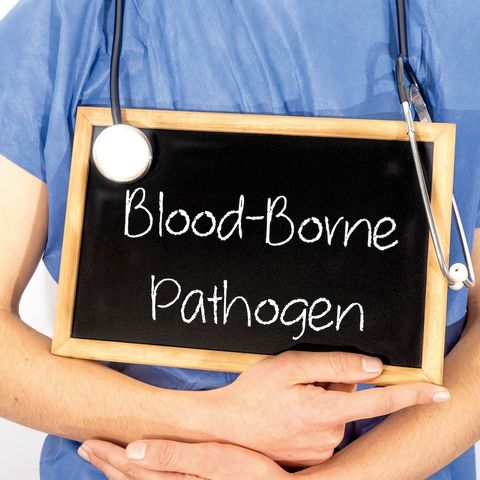
Contatti
Info
Bloodborne pathogens refer to infectious microorganisms that can be present in human blood and certain other bodily fluids. These pathogens, including viruses, bacteria, and parasites, can cause diseases and infections...
mostra di più- Common Bloodborne Pathogens: The most common bloodborne pathogens include the Human Immunodeficiency Virus (HIV), Hepatitis B Virus (HBV), and Hepatitis C Virus (HCV). These viruses can cause severe and chronic infections, potentially leading to long-term health complications.
- Modes of Transmission: Bloodborne pathogens can be transmitted through various routes, including needlestick injuries, sharps-related injuries, contact with infected blood or OPIM through broken skin, mucous membranes, or non-intact skin, and, in rare cases, through sexual contact or from mother to child during childbirth.
- Occupational Risk: Certain occupations pose a higher risk of exposure to bloodborne pathogens, including healthcare workers, first responders, laboratory personnel, and custodial staff. Workers in these fields are often trained in infection control practices and provided with personal protective equipment (PPE) to minimize the risk of exposure.
- Prevention and Control: Preventing the transmission of bloodborne pathogens involves implementing strict infection control measures. This includes proper hand hygiene, safe handling and disposal of sharps, using appropriate PPE (e.g., gloves, masks, protective eyewear), practicing universal precautions (treating all blood and OPIM as potentially infectious), and following standard protocols for disinfection and sterilization.
- Vaccinations: Vaccinations are available for certain bloodborne pathogens, such as Hepatitis B. Vaccination programs are commonly implemented for healthcare workers and other at-risk individuals to provide immunity and reduce the risk of infection.
- Training and Education: It is essential for individuals at risk of exposure to receive training and education on bloodborne pathogens. This training typically covers topics such as infection control practices, safe work procedures, recognizing potential hazards, and appropriate response in case of exposure incidents.
- Post-Exposure Protocol: In the event of an exposure incident, it is crucial to have a clear post-exposure protocol in place. This includes immediate first aid measures, reporting the incident to the appropriate authorities, seeking medical evaluation, and following any necessary follow-up procedures, such as testing, counseling, or prophylactic treatments.

Bloodborne pathogens refer to infectious microorganisms that can be present in human blood and certain other bodily fluids. These pathogens, including viruses, bacteria, and parasites, can cause diseases and infections...
mostra di più- Common Bloodborne Pathogens: The most common bloodborne pathogens include the Human Immunodeficiency Virus (HIV), Hepatitis B Virus (HBV), and Hepatitis C Virus (HCV). These viruses can cause severe and chronic infections, potentially leading to long-term health complications.
- Modes of Transmission: Bloodborne pathogens can be transmitted through various routes, including needlestick injuries, sharps-related injuries, contact with infected blood or OPIM through broken skin, mucous membranes, or non-intact skin, and, in rare cases, through sexual contact or from mother to child during childbirth.
- Occupational Risk: Certain occupations pose a higher risk of exposure to bloodborne pathogens, including healthcare workers, first responders, laboratory personnel, and custodial staff. Workers in these fields are often trained in infection control practices and provided with personal protective equipment (PPE) to minimize the risk of exposure.
- Prevention and Control: Preventing the transmission of bloodborne pathogens involves implementing strict infection control measures. This includes proper hand hygiene, safe handling and disposal of sharps, using appropriate PPE (e.g., gloves, masks, protective eyewear), practicing universal precautions (treating all blood and OPIM as potentially infectious), and following standard protocols for disinfection and sterilization.
- Vaccinations: Vaccinations are available for certain bloodborne pathogens, such as Hepatitis B. Vaccination programs are commonly implemented for healthcare workers and other at-risk individuals to provide immunity and reduce the risk of infection.
- Training and Education: It is essential for individuals at risk of exposure to receive training and education on bloodborne pathogens. This training typically covers topics such as infection control practices, safe work procedures, recognizing potential hazards, and appropriate response in case of exposure incidents.
- Post-Exposure Protocol: In the event of an exposure incident, it is crucial to have a clear post-exposure protocol in place. This includes immediate first aid measures, reporting the incident to the appropriate authorities, seeking medical evaluation, and following any necessary follow-up procedures, such as testing, counseling, or prophylactic treatments.
Informazioni
| Autore | Compliant Experts |
| Organizzazione | Christian Robbins |
| Categorie | Istruzione |
| Sito | - |
| christian@compliantexperts.com |
Copyright 2024 - Spreaker Inc. an iHeartMedia Company
